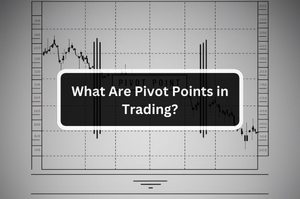What Are Pivot Points in Trading? – Modest Money

Pivot Points are a technical analysis indicator that uses the previous day’s price action as a metric for determining current price trends.
The main line is simply an average of the previous day’s high, low and closing price.
This line represents a summary of the previous day’s price action that the current day’s price action can be measured against.
Traders can also use additional lines derived from this main line that act as resistance and support levels that measure the strength of trends and act as locations for potential price reversals.
The use of Pivot Point levels is similar to the Fibonacci Retracement Strategy, but the support levels and resistance levels are based on different metrics.
Similar to Fibonacci levels, these points are particularly useful in Breakout Trading Strategies, where they represent the most likely points for breakouts.
As an intraday indicator, it is most often used by day traders and swing traders.
Key Takeaways
- Pivot Point levels are a representation of the previous day’s price action that can be used to measure the current day’s price action.
- They are used to measure the strength of trends and indicate likely support and resistance levels for breakouts or price reversals.
Pivot Point levels are a simple representation of the previous day’s price movements.
The main line is the average of the previous trading day’s high price, low price and closing price.
The additional lines are simply further extensions of the previous day’s price action involving the main line and the previous trading day’s highs and lows.
The number of supplemental lines available will depend on the trading platform used, but most trading platforms offer at least the supplemental R1, R2, S1 and S2 lines.
While this range-based analysis can be considered overly-simplistic, it is a very efficient way to represent the previous day’s price action.
Therefore, it is recommended that they be used with other forms of analysis and other technical indicators.
How to Calculate Pivot Points
The main line formula is a simple average of the previous trading day’s highest price, lowest price and closing price.
P = (High Price + Low Price + Closing Price) / 3
The other Pivot Point calculations are simple formulas involving these same original numbers.
- R1 = (P × 2) − Low Price
- S1 = (P × 2) − High Price
- R2 = P + High Price − Low Price
- S2 = P − High Price − Low Price
How to Use Pivot Points
The use of pivot levels is based on the simple assumption that the current day’s price action is heavily influenced by the previous day’s price action.
The main line represents the previous day’s price action that the current day’s price can either underperform or outperform.
This core analysis is used to determine the existence and strength of price trends.
The supplemental lines are used as resistance levels and support levels.
These levels can also be used in the analysis of trends, but are more often used as likely locations for breakouts and price reversals.
Trends
The main use for Pivot Points is for identifying trends and determining their strength.
Since the main line represents a summary of the previous day’s price action, the location of the current day’s price action relative to the main line shows the direction of the day’s price trend.
- If the current day’s price action is above the main line, this is a bullish trend.
- If the current day’s price action is below the main line, this is a bearish trend.
Similarly, the distance between the current day’s price action and the main line shows the strength of the trend.
- If the current day’s price action is far from the main line, this is a strong trend.
- If the current day’s price action is close to the main line, this is a weak trend
Breakouts and Reversals
The other common use for pivot levels is as an indicator for the likely locations of breakouts and reversals.
As extensions of the previous day’s price action, these resistance and support levels represent psychological barriers to the previous trading day’s price action that will likely still be influencing the price chart on the current trading day.
However, these supplemental lines do not offer enough information on their own to act as entry and exit points for trades.
Instead, they should be used after other indicators have identified a likely breakout or reversal as the most likely location for this price action to take place.
The supplemental lines are most commonly used with momentum indicators that can determine when a breakout or reversal is likely to happen.
The Best Tools for Trading with Pivot Points
Pivot Points are an excellent technical analysis tool due to their simplicity and clear visual cues.
However, they need to be used in conjunction with other technical indicators for actual trade execution.
Traders need market research tools that allow them to explore a range of indicators in the development and execution of their trading strategies.
Our top recommendations for market research tools for retail traders are:
Learning how to use Pivot Points effectively is a process of trial and error.
The only way to learn from past experience is to keep meticulous notes on past trades that can be analyzed using the latest information-parsing technology.
Our top recommendation for trading journals for retail traders is:
Related Links
Source link




